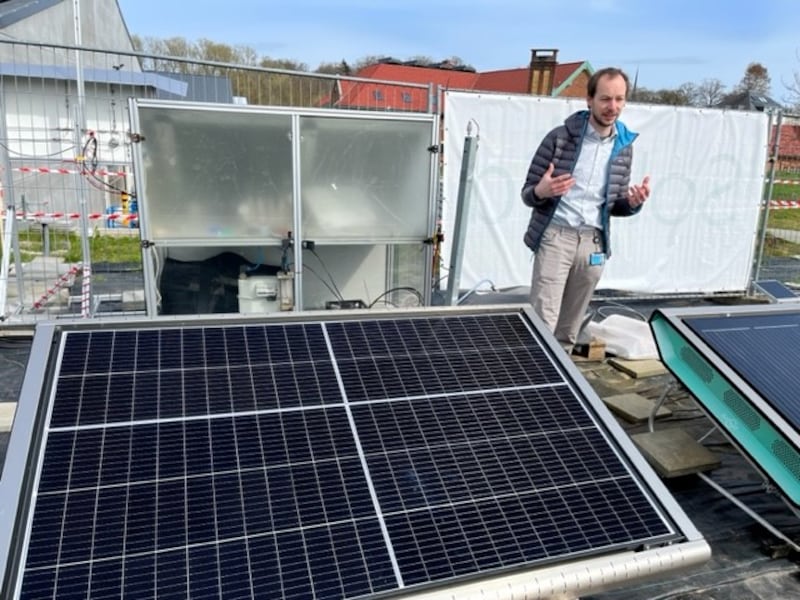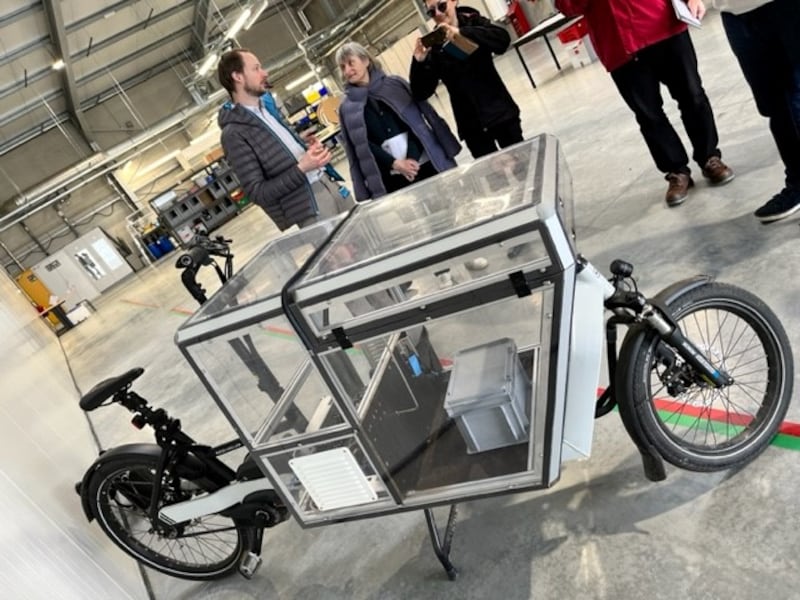The energy crisis and the need to reduce carbon emissions while phasing out fossil fuels is driving unprecedented energy innovation across Europe. The possibilities of combining technologies to maximise the performance of clean energy are arousing much interest.
The breakthrough by Belgian scientists Jan Rongé, Johan Martens and Tom Bosserez, is a superb illustration of this. They invented and developed the prototype of a solar panel that produces green hydrogen gas from sunlight and ambient moisture.
Hydrogen, which does not generate emissions, is clearly going to play a role in heavy transport (trucks, rail and shipping), in making green steel, in fertiliser production and to be adopted in sectors with emissions that are either prohibitively costly or impossible to reduce with currently available abatement technology.
But they raise the possibility of making renewable hydrogen “accessible for anyone, anywhere”.

“We realised we could use ambient air as a source of water: it turns out that the amount of sunlight a surface receives matches quite well with the amount of water you can capture from the surrounding air. This insight allowed us to develop an integrated device that is fully autonomous and doesn’t need any inputs,” Rongé explains.
The research project initiated in 2011 emerged from research at KU Leuven University in Belgium, from which the start-up Solhyd emerged. It is at the point of major scale-up of production with the patented device.
Their hydrogen modules (panels) are similar to classical solar photovoltaics but instead of an electric cable, they are connected via gas tubes. Just like solar panels, they can be used in many ways.
Hydrogen panels can be installed on the roof of a building or out in a field, but many applications are being explored; from energy provision, to industry or mobility solutions. To demonstrate the range of possibilities, they even developed a hydrogen-powered carrier bicycle.
“During that journey, what drives us has always remained the same: develop a technology that produces renewable hydrogen anywhere, at any scale to help tackle climate change,” he says.
In the context of the world going to “100 per cent renewable energy, fast”, there is a need for many technologies and energy carriers to achieve that, Rongé adds. “Hydrogen is the most efficient fuel we can make from renewable energy, and it does not release carbon when it is consumed. It can be used to store large amounts of renewable energy or transport it over long distances.”
There is a scenario where Solhyd may have a particular advantage, he explains. “The electrical grid cannot handle all the renewable electricity that is being produced. And we have to increase it tenfold. And then there are applications like industry or heavy-duty trucks, which need a renewable fuel like hydrogen.”
Hydrogen is perfect for electricity generation when it comes to the energy transition, he believes — and it helps solve intermittency problems, ie when the sun doesn’t shine. Hydrogen panels are an additional option to produce large amounts of renewable energy, while fossil gas can be replaced with renewable hydrogen in many applications with minimal adjustments.

Even the gas grid is suited for transporting hydrogen, he says. Much like photovoltaics injecting electricity on the electrical grid, hydrogen panels could inject hydrogen into the gas grid.
Solhyd is investigating whether hydrogen panels could be connected to the gas grid “to help green our gas consumption”. Gas quality is being tested in collaboration with the gas infrastructure company Fluxys. The possibility of injecting hydrogen in local distribution grids has also been evaluated, where hydrogen panels were used to produce renewable methane gas.
Rongé outlines how they have integrated solar energy capture and water capture from air to obtain modular hydrogen units “that provides access to green hydrogen for anyone, at any scale”.
The contrast with expensive electrolysers, technology to split water and generate hydrogen, stands out. It is a low-cost option capable of using water that is in the air anywhere in the world except the hottest deserts. High-powered electrolysers use a lot of rare earth metals and require demineralised water.
“Solhyd panels reduce complex infrastructure to a single device that is plug and play ... [with] direct input of nearly free energy,” he notes.
Further applications
This possibility offers huge potential for more than two billion people on the planet who are cooking with polluting fuels. This causes four million deaths per year and the use of wood for cooking is a major cause of deforestation, besides being responsible for up to five per cent of global greenhouse gas emissions.
Polluting cookstoves using wood, charcoal or fossil fuels could be replaced by a hydrogen stove, he says. Solhyd is investigating how hydrogen panels could be used to provide households in the Global South access to clean cooking facilities.
Separately, some one billion people lack access to clean energy. In many locations, such as islands, diesel fuel is imported to produce electricity in (backup) power generators. “Hydrogen panels would be able to provide on-site renewable hydrogen for various applications,” Rongé says.
While hydrogen fuel generated from electricity-generated renewables such as offshore wind fed into large electrolysers will be the backbone in industrial clusters in much of Europe, he says. Solhyd will be an ideal solution in other scenarios such as SMEs, “which will be able to make their own hydrogen rather than having to have it delivered by truck”.
Rongé expects hydrogen panels to be commercially available from 2026 onwards but it could take somewhat longer before their panels are available to individuals. Larger companies and organisations are already seeking to co-operate with scale-up of the technology; especially those wishing to get off natural gas.
“We shouldn’t underestimate the onshore potential of hydrogen in Europe,” he says.















